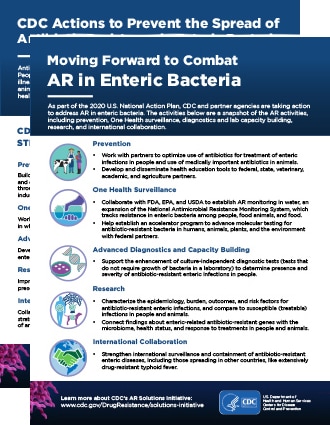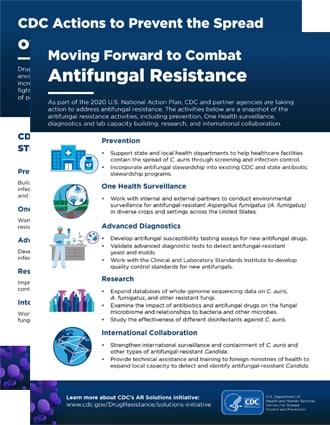Antimicrobial Resistance
Antimicrobial resistance is one of the world’s greatest public health challenges. Antimicrobial resistance happens when germs like bacteria and fungi develop the ability to defeat the drugs designed to kill them.
The Division of Foodborne, Waterborne, and Environmental Diseases (DFWED) is working to slow the development and spread of antimicrobial resistance in bacteria that cause intestinal illness (enteric pathogens) and fungi through research, surveillance, and outreach aimed at improving the public’s health.
DFWED addresses antimicrobial resistance using a One Health approach, which recognizes the health of people is closely tied to the health of plants, animals, and our shared environment. DFWED’s efforts are part of CDC’s Antimicrobial Resistance Solutions Initiative and are centered around the goals of the U.S. National Action Plan for Combating Antibiotic-Resistant Bacteria (National Action Plan).
Learn more and see data about antimicrobial resistance in select enteric pathogens:
Enteric Bacteria
Three common enteric bacteria—Campylobacter, Salmonella, and Shigella — cause about 740,000 antimicrobial-resistant infections each year in the United States. These bacteria are becoming more resistant to some antibiotics that are important for treating severe infections, limiting treatment options.[i]
DFWED relies on surveillance, laboratory and epidemiologic analysis, collaboration, research, and innovation to identify antimicrobial-resistant enteric bacteria and prevent their spread by:
- Tracking the antimicrobial resistance of foodborne and other enteric bacteria causing human illness through the National Antimicrobial Resistance Monitoring System (NARMS).
- NARMS is a collaboration among public health departments, CDC, the U.S. Food and Drug Administration (FDA), and the U.S. Department of Agriculture (USDA).
- NARMS tracks changes in bacteria found in ill people (CDC), retail meats (FDA), and food animals (USDA).
- Responding to multistate outbreaks caused by resistant enteric bacteria by providing epidemiologic expertise and rapid laboratory analysis of resistance patterns. Some of these outbreaks are linked to contaminated food or contact with farm animals, livestock feed, pets, or pet food and treats.
- Collaborating with partners at FDA and USDA to improve antibiotic and antifungal use in veterinary medicine and agriculture.
- Funding innovative projects to identify and respond to the threat of antimicrobial resistance in the United States and around the world.
CDC Actions to Prevent the Spread of Antibiotic Resistance in Enteric Bacteria [PDF – 2 pages] under the National Action Plan.
Fungal Pathogens
Learn more and see data about resistance in Candida auris and other Candida species.
Only three types of antifungal drugs exist for severe fungal infections, so resistance to antifungals can severely limit treatment options. Some types of fungi, like Candida auris (C. auris), can become resistant to all three drug options, and these infections can be very challenging to treat. The number of cases of the drug-resistant fungus C. auris continues to increase each year, with about 700 clinical cases reported in the United States in 2020, and about 28,000 cases of any species of antimicrobial-resistant Candida among hospitalized patients.[i] Annual clinical cases of C. auris increased by 95% to about 1,400 in 2021.[i]
CDC Actions to Prevent the Spread of Antifungal Resistance [PDF – 2 pages] under the National Action Plan.
The fungus Aspergillus fumigatus is a type of mold that is increasingly resistant to antifungal drugs. Antifungal resistance can occur in the environment and then spread to some people and make them sick. It can also occur in patients who are sick with an Aspergillus fumigatus infection and have been taking antifungal drugs for a long time. Learn more about antimicrobial-resistant fungi.
DFWED scientists address the threat of antimicrobial-resistant fungi through surveillance, clinical and environmental research, laboratory innovations, outbreak response, and supporting stewardship initiatives. Find out more about how DFWED is tackling antimicrobial-resistant fungi.
Antimicrobial Resistance Innovation Projects
By awarding competitive grants to universities, state and local health departments, and other partners, CDC invests in innovative research projects to help identify and implement new ways to respond to antimicrobial resistance globally. available. Through these investments and partnerships, CDC is transforming how the nation and world combat and slow antimicrobial resistance at all levels.
View a complete list of AR innovation projects.

